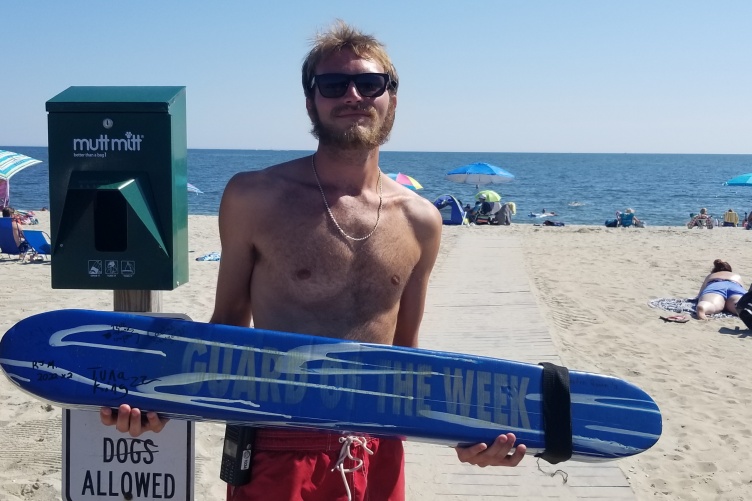
Nate Rowe ’25 earned praise from beachgoers and recreation department staff alike for rescuing four children from the water in Cape Cod this summer. (Courtesy photo)
Nate Rowe ’25 had no idea when he reported to his summer gig as a lifeguard in Harwich, Massachusetts one Wednesday in early August that he was about to become a local hero and celebrity. What began as a quiet shift quickly became anything but, in a scene that ultimately inspired comparisons to the most famous shark attack movie in American cinema.
Rowe sprinted into the water to help rescue four swimming children after beachgoers spotted a fin moving along near the shore. He successfully got the children to safety, and only after the rescue was it determined the fin belonged to a wounded tuna and not a shark.
Rowe’s heroics were covered in a story in the Cape Cod Chronicle, in which he is referred to as a “true hero” by one beachgoer, who invoked the movie Jaws as the best comparison for the chaotic scene.
“The kids out deeper were completely panicked and frozen,” Maura O’Neil says in a letter quoted in the Cape Cod Chronicle story. “To me it seemed like a scene from Jaws with the crowd screaming, ‘swim, swim!’ Most drama I have seen in the 35-plus years I have been coming down to the Cape.”
We caught up with Rowe a few weeks after the rescue so he could share some details of the day’s events in his own words.
What was going through your mind when you first saw the fin?
My first thought was that it was a shark feeding in the water. As I ran, I was focused on clearing the water and getting everyone out.
What did you see/hear that pushed you into action?
There were a few children screaming at first, which is usually just play, but as soon as adults started screaming and the fin was visible, I immediately jumped out of the stand.
When did you find out it was a tuna and not a shark? What was your reaction?
After I was back on shore and had begun talking with a few people. I was super relieved to hear that it ended up being an injured tuna and not a shark.
The news story said it was your first rescue. How did you focus and rely on your training with your adrenaline running high in the moment? What elements of your training were most useful in the situation?
It was very quick, and I had to act instantly. I have been guarding for five years now and going over drills and incidents and training so much it was almost muscle memory. I just knew what I had to do. There were so many people screaming and yelling and just so much commotion – I'm glad that in my training my instructor told us about real-life situations and everything to expect and how to handle it, and even helped us act out scenarios in CPR training to help respond to the pressure of a real-world situation.
What did the kids say when you got out to them to bring them in? How did you help get them in?
The children didn't say much because they were all screaming and crying and pretty distressed. I grabbed the surf rescue board and paddled out to them as fast as possible and told them all to get on the board, and even needed to help the smallest and most troubled swimmer to the board and push him on. As soon as they were all on, I pushed the board in part-way by just swimming before I was able to get my knees on the back of the board and paddle in at full speed.
Now that people are calling you a hero, have you started practicing your slow-mo Baywatch run yet?
A few beachgoers did start calling me King Tuna, and I had begun to be recognized in public.
-
Compiled By:
Keith Testa | UNH Marketing | keith.testa@unh.edu



















































